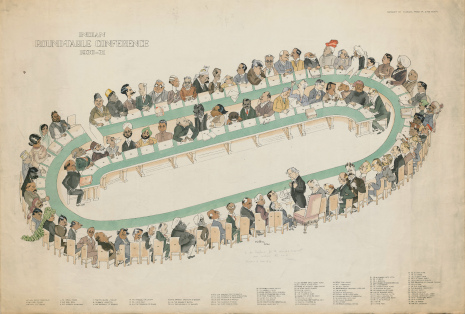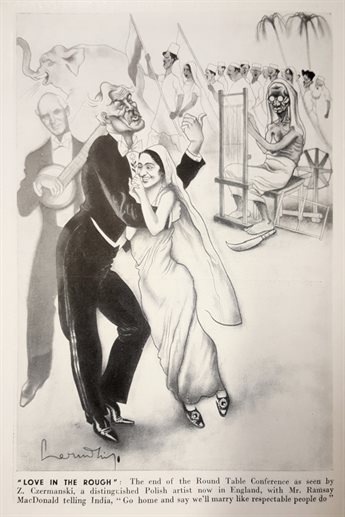Caricature
Emery Kelen (1896-1964) was one of the, if not the, most famous caricaturist of the interwar period. Pulled out of art college and drafted into the Hungarian army during the First World War, Kelen emerged as a lifelong opponent of war. In the 1920s, often collaborating with Alois Derso, Kelen crafted the art of depicting the political and diplomatic scene. Conferences were one of his key sites, with sought-after drawing produced at the 1925 Locarno Conference, the 1933 London Economic Conference, the 1932 World Disarmament Conference, and at the permanent conferencing of the League of Nations in Geneva. Lithographic portfolios could also be commissioned, as with these portraits (individual and table) produced during the first two sessions of the Round Table Conference.

Emery Kelen, "Indian Round Table Conference 1930-31". Coloured print. 1931. Courtesy of British Library (shelfmark P 1524).
Kelen devotes a chapter of his reminiscences of the interwar period, Peace in Their Time (1963), to his coverage of the conference. He dismissed it politically, suggesting the delegates had been selected to create as little nuisance as possible; the sort of people who enjoyed watching white men carrying burdens. But he devoured it socially, relishing the mixes and clashes of personalities. While he clearly had Indian friends, he lapsed frequently into orientalist stereotypes of the irrational Indian, barely separate from the state of nature. Here, he recalled the opening of the conference in November 1930: “Imagine the House of Lords gone mad. I sat in the balcony listening to King George V opening the Round Table Conference, and spread below me were the great banks of turbans, fluorescent in the Gothic dusk, sulphur yellow, hellish red, poison green, and shocking pink, and when the king had done they came to life and popped around like fireflies.” Added to his usual accentuation of body shape and facial expression came a whole new range of racial colouring.
For the few female delegates there could also be a dose of body-shaming and casual misogyny. During the second conference session the Maharani of Baroda organised a charity ball to benefit Charing Cross Hospital. Kelen drew caricatures of the Indians there present and Sarojini Naidu later wrote to her children of the event that: “Another long interval was occupied by a cartoonist then who is brilliant and very cruel. We had some R.T.C. cartoons then and there to the merriment of the audience; the one of me is terrible but it sold for 15 guineas then and there in aid of children’s hospital.”[1] Kelen later described Naidu as one of the ladies “… who eat Hungarian caricaturists for breakfast. Her generous mouth followed an upward curve and ended in a malicious curl underscored by the shadow of a moustache.” He compared her gait to that of a pouter pigeon and criticised her use of golden jewellery. He admired her political work “But face to face with my white paper, I became an ugly truth-teller. From the day I drew Mrs. Naidu’s portrait for the benefit of the Charing Cross Hospital, and half of Who’s Who roared, I lost a valued friend… Fat poetess! I am one with Luther at the Diet of Worms: ‘Here I stand, I cannot do otherwise. God help me! Amen.”
[1] Makarand Paranjape (Ed.), Sarojini Naidu Selected Letters 1890s to 1940s (New Delhi: Kali for Women; 1996), p. 255
Zdzisław Czermański

Zdzisław Czermański, 'Love in the Rough'. Published in The Graphic, vol. 131, issue of 31 Jan 1931
The Polish artist Zdzisław Czermański (c.1900-1970) had by a young age established a Europe-wide reputation as a political cartoonist. He began earning commissions while serving in the Polish Army, and from 1928 worked full-time as a cartoonist for some of Europe and the US’s biggest newspapers and magazines, spending much of his time in London, Paris and New York, where he was to move permanently in 1941. This work, captioned “Love in the Rough”, satirised the Round Table Conference with reference to the 1930 golf-course-set Hollywood romantic-comedy film of the same name. Ramsay MacDonald and the Begum Shahnawaz are cast as the lead couple who fall in love at a country club and elope; the line ‘Go home and say we’ll marry like respectable people do’ is taken from a line from the film’s central musical number, a popular hit of the day. Shahnawaz was the star turn of the Movietone news footage of the concluding session of the first conference session, presided over by MacDonald. She was denounced by Indian feminists for her conciliatory politics, perhaps represented in her poise. Sir John Simon, whose constitutional report was superseded by the conference deliberations, has faded into the background here, playing second fiddle (or banjo). In the background homespun-cloth wearing Congress supporters march, framing a sinister looking Gandhi with a machete threateningly resting by his feet. This re-forged connections made in right-wing newspapers between this advocate of non-violence and the threat of Indian revolution.
Paolo Garretto

Paolo Garretto, 'Gandhi the Tail-Salter'. Published in The Graphic, vol. 128, issue of 24 May 1930
Paolo Garretto (1903-1989) was an Italian artist whose airbrush style was highly in-demand in the 1920s and 30s. After early training as an artist and architect, Garretto was briefly caught up in the Fascist movement, for a year serving as a member of Mussolini’s personal honour guard, before obtaining a permanent discharge in 1925. Thereafter he started earning commissions from magazines and newspapers across Europe, living between Rome, Paris, London and New York. This piece, entitled “Gandhi the Tail-Salter”, satirises MK Gandhi’s march to flout the British salt laws in March-April 1930 as ‘salting the tail’ of the British lion, thus rendering it captive in the manner that salting the tail of a bird, according to folk superstition, prevented it from flying away. After its initial publication in The Graphic, this piece was reprinted in the American magazine Fortune, and prompted Vanity Fair to hire Garretto, who would go on to draw many of their covers through the 1930s.